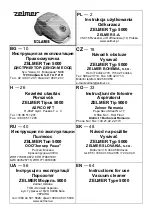
Documents are only to be used and distributed completely and unchanged, especially including the section ”Safety information”. This is page 46 of a document consisting of
49 pages. The instructions for use describe only the actual product. If the product is older or newer than the date of writing, it is strictly the users´ responsibility to check carefully
the validity of the document (if in doubt, order appropriate instructions for use). 99 90 34 / 12/09/2003
Round bottom flask 500 ml
, coated ......................
63 84 97
O-ring
28 x 2,5 .....................................................
3 12 05 53
(FPM, e. g. Viton®) at the spherical ground joint of the round
bottom flask at the inlet
☞
Remove union nut at the condenser and remove hose from
the inlet of the condenser.
☞
Pull off old overpressure safety relief device and install new
one.
☞
Connect hose to the inlet of the exhaust waste vapour con-
denser and tighten union nut.
Overpressure safety relief device
.........................
63 88 21
(at the exhaust waste vapour condenser)
Cleaning and assembling components
Calibration in the factory
Control of measuring equipment
The
VACUUBRAND DKD calibration laboratory
is accredited by the Physikalisch-Technische
Bundesanstalt (PTB; German national institute for science and technology and the highest technical authority
of the Federal Republic of Germany for the field of meteorology and certain sectors of safety engineering)
for the measurable variable
pressure in the pressure range from 10
-3
mbar to 1000 mbar
in accordance
with the general criteria for the operation of testing laboratories defined in the EN 45000 series of standards.
Calibration in the VACUUBRAND calibration laboratory:
-
To meet the requirements of the DIN ISO 9000ff and 10012 series of standards regarding the calibra-
tion of inspection, measuring and test equipment at specified intervals.
-
To document that the vacuum gauges calibrated are traceable to national standards of the PTB.
Cleaning the gauge head VSK 5
The gauge itself is maintenance-free.
If the vacuum system is contaminated (oil, particles, etc.), contamination of the pressure transducer will
influence the accuracy of measurement.
➨
➨
➨
➨
➨
Fill the gauge head chamber with a solvent (e. g. benzene) and allow sufficient cleaning time. Observe
all regulations concerning usage and disposal of solvents!
➨
➨
➨
➨
➨
Drain the solvent and dispose of in accordance with regulations, repeat cleaning if necessary.
➨
➨
➨
➨
➨
Rinse the gauge head chamber several times with alcohol in order to remove all solvent residues.
☞
Never use a spiky or sharp-edged tool to clean the pressure transducer.
➨
➨
➨
➨
➨
Allow the pressure transducer to dry.
➨
➨
➨
➨
➨
Readjust the pressure transducer if necessary.




































